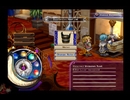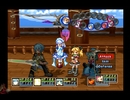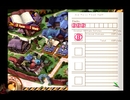|
|

|
PLATFORM
|
PS2
|
BATTLE SYSTEM
|

|
INTERACTION
|

|
ORIGINALITY
|

|
STORY
|

|
MUSIC & SOUND
|

|
VISUALS
|

|
CHALLENGE
|
Adjustable
|
COMPLETION TIME
|
More than 80 Hours
|
|
OVERALL

|
+ Solid alchemy and battle systems.
+ Great soundtrack.
+ Basically two games in one
- Gust's trademark lag.
- Story could have been better-developed.
- Weak English voicework.
|
Click here for scoring definitions
|
|
|
Al-Revis Academy, known for producing some of the greatest alchemists in the world, has experienced a decline in quality teachers. There has also been a decline in the power of Mana throughout the world, causing the Academy to fall to the earth. Two students, a boy with a dark named Razeluxe, and a girl from a small village named Ulrika, enroll at the school, making friends and crossing paths during their campus lives. Gust's Mana Khemia 2: Fall of Alchemy, continues to breathe life into the PlayStation 2's RPG selection years after its successor system's release, and proves to be a solid sequel.
The sequel allows the player to play as either Raze or Ulrika, with each character having different allies that join them at school. Like its predecessor, Mana Khemia 2 adopts a methodical formula where the player must complete various school assignments for each term that consist of different tasks such as gathering certain kinds of items in dungeons, fighting certain enemies, and the like. After completing the assignment, the player receives a grade depending upon their performance and a corresponding number of units, with ten units being necessary to complete the term.
If the player does not obtain enough units from the term's assignments, then they receive detention, where they must perform additional tasks to advance the story. However, if the player obtains the required units, then they receive free time, during which they can take up jobs that involve killing special enemies or synthesizing items with specific traits for money. Players can also initiate Character Quests during free time to reveal more about a particular character or sell synthesized items at a bazaar. After free time, a main story event typically occurs.
 Allies can help increase synthesized item quality
Allies can help increase synthesized item quality
|
|
Synthesis plays a major role in the game, with the player able to synthesize consumable items, ingredients, weapons, armor, and accessories at the chosen protagonist's workshop. In the recipe selection lists, items with stars next to them indicate that the player can discover alternate recipes while selecting ingredients, while items with light bulbs indicate that the player can unlock another recipe depending upon which character the player chooses to help synthesize the item. If the player lacks a particular ingredient in a recipe that happens to be another synthesizable item, they can select that item during ingredient selection to synthesize it if its own ingredients are available, a handy shortcut that saves some time.
After selecting a recipe's ingredients, the player can select one of the protagonist's allies to help with the synthesis, each having helpful abilities such as providing bonus points to ingredients of specific elements (fire, water, earth, and wind). During each ingredient's selection, a wheel with circles representing said elements (along with a blank circle) rotates, with the player able to select one of the circles. If the circle chosen corresponds with the ingredient's element (if it has a positive number), then a number indicating the item's quality will increase; if the player chooses the opposite element, the quality will decrease. However, if the ingredients have negative numbers, then the elemental circles will have opposite effects on the item's quality, which has a maximum number of a hundred.
Item synthesis is necessary to advance each character's stats and abilities, with each having a Grow Book with many cards indicating item recipes. Each of these cards has three "grow factors" that indicate a stat increase or new/upgraded ability, with two initially available, and the third unlocked if the player manages to increase a synthesizable item's quality to a hundred points. To obtain these increases, each character must use AP obtained from winning battles; as characters obtain grow factors, they may obtain "titles" that provide effects such as decreasing wait time after using items, increasing overall stats, and so forth.
Battles themselves occur in dungeons (which also have gathering points where the player can find ingredients for synthesis), with blue and red blobs indicating encounters wandering around. When the player contacts one, one of the face buttons will appear, with the player needing to press that button to gain the initiative in the encounter if the blob is red; if the blob is blue, on the other hand, it will disappear, leaving behind an item. If the player hesitates too long before pressing one of the face buttons, the enemy will gain the initiative in the following encounter.
 Fun battles
Fun battles
|
|
Combat is turn-based, with spheres indicating the player's three active characters, known as vanguards, and enemies, populating a circular turn order gauge. When a character's sphere reaches the left edge of the clockwise-moving gauge, the player can select a command. These include attacking normally, using an SP-consuming skill, defending (with the player able to select when they'll take their next turn), using an item, switching with one of up to two support characters (and occasionally a guest character), or attempting to escape, which has less chance of success at nighttime. Vanguards switched out of battle will need to "recharge" before the player can swap them in battle again, during which their SP gradually recovers.
As the player's characters attack the enemy, a Unite Gauge gradually fills up to 100%, although enemies attacking the player's characters will decrease it. Exploiting the enemy's weaknesses fills up the Gauge more quickly, and once it reaches 100%, Unite Mode will occur, where support characters recharge and recover SP more quickly, and the player can use Intimate Strike and Guard. As a vanguard uses a normal attack or offensive skill, the player can swap them with a support character who contributes his or her own attack, and in Unite Mode, the player can swap that character with a second support character to execute a powerful Intimate Strike. While the enemy is attacking a vanguard, furthermore, the player can again switch them with a support character, and in Unite Mode swap that character with a third support character to execute an Intimate Guard, which may have an offensive or defensive effect.
Using support actions during Unite Mode fills up the Finishing Gauge, which, when full, allows the player to execute a powerful Finishing Strike against an enemy. Unite Mode ends when the Unite Gauge falls back down to 0% or the player uses a Finishing Strike. Winning a battle nets all characters AP to use in their Grow Books, money, and occasional items; playing the game on Hard mode (with difficulty adjustable between Normal and Hard), both increases the challenge of battles and AP rewards. Overall, both item synthesis and combat are enjoyable, with battles usually ending quickly, though an option to skip the longer spell animations would have been nice. Getting 100 quality for all items to complete each character's Grow Book can also be somewhat challenging, but the gameplay doesn't leave too much to desire otherwise.
The controls could have been a little better, though. Mana Khemia 2, however, does an excellent job keeping the player moving in the right direction, but the sequel suffers from Gust's trademark lag during menu navigation, and the lack of an equip-best option can make managing character equipment somewhat difficult. A scene skip option would have been nice as well, although during cutscenes, the player can press the triangle button to view previous dialogue in the scene. There's also the potential for a game freeze during a sidequest battle, but the game is luckily devoid of other nasty bugs or freezes otherwise. Ultimately, interaction isn't perfect, but could have certainly been much worse.
 Better do your homework
Better do your homework
|
|
Mana Khemia 2 largely derives its mechanisms from its predecessor, albeit with minor tweaks such as two different protagonists and less linearity for character Grow Books, with the storyline following the same structure as well. While it is interesting to view the storyline from two different protagonists' perspectives, the main plot could have used more development and even a greater sense of conflict, although the characters definitely have their own quirks. An extra chapter unlocked after completing both heroes' storylines provides a sense of closure, but the overall structure of the game somewhat mars the narrative's pacing and potential.
Like most other Atelier games, Mana Khemia 2 has a nice variety of bouncy, upbeat, energetic music, not to mention a few vocal theme songs. The English voice acting, though, is largely poor, with some miscast characters like Pepperoni and Enna, though luckily, players can switch to the Japanese voices. The sequel also largely uses its predecessor's visual style, combining 2-D sprites with 3-D scenery, along with static character art narrating cutscenes. The combination mostly looks decent, though some of the scenery could have used more polish. In the end, the second Mana Khemia looks decent, but sounds better.
Finally, fully completing the sequel, which includes going through both protagonists' storylines and the epilogue chapter, takes more than eighty hours (though this reviewer's final time said sixty-five hours, the game clock is way too slow), with the New Game+ feature allowing for limitless playthroughs. Overall, Mana Khemia 2 is a solid sequel that hits most of the right notes in terms of gameplay while leaving a little room for improvement in areas such as control and the story. Nonetheless, those that enjoyed the first game and don't mind that its successor is largely the same will likely have a good time, while those who think that RPGs have to innovate in order to be good probably won't.
Review Archives
|









